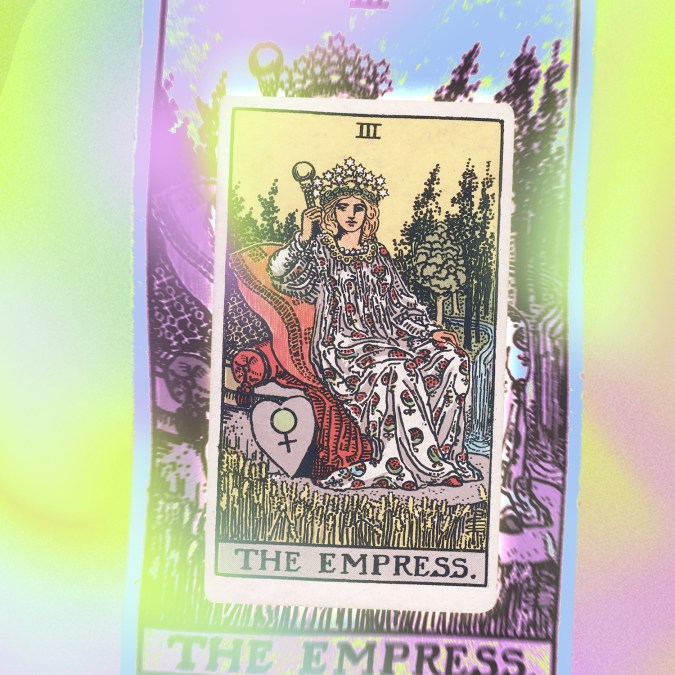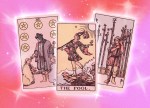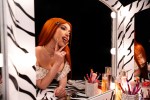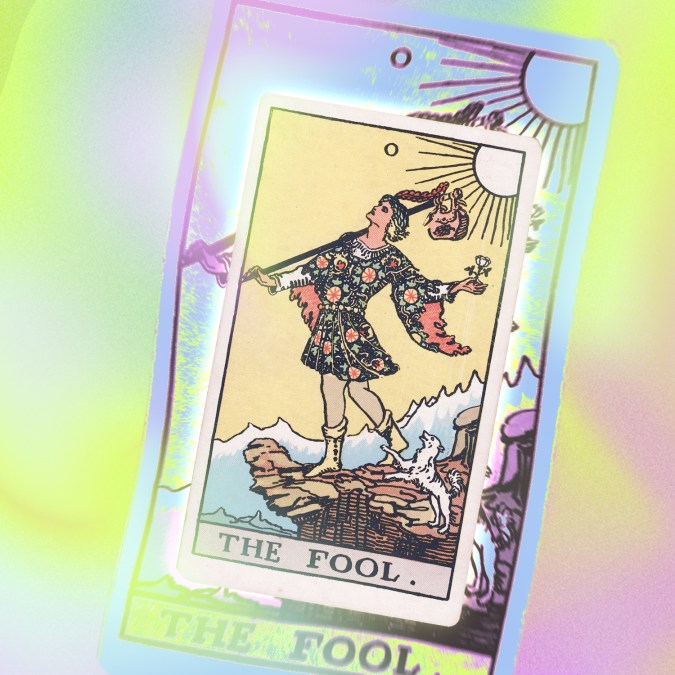When it comes to astrology and tarot, those of us in the queer community are probably obsessed. In fact, according to a 2024 Fall survey by Pew Research Center, a little over half of U.S. queer and trans adults (54%) consult astrology, compared to just 28% of U.S. adults overall. And, 33% of queer adults say they consult tarot cards — a rate three times higher than the average. But… is tarot and astrology built for us?
At first glance, it may seem like astrology and tarot share a very cis-gendered and heteronormative perspective. There are plenty of examples to choose from — whether it’s how awful Cancer men are, how wonderful the women are in the Zodiac, or the masculine and feminine energy of certain signs and tarot cards. While we know queer and non-binary people have existed for as long as humans have been around, they’ve only been part of our post-colonial zeitgeist and accepted without lawful intervention (if that) in the last few decades.
Astrology and tarot, on the other hand, are divination tools and traditions since as far back as ancient times. The earliest concept of a form of astrology can be traced to the Babylonians in the first millennium BC, and it has evolved over several centuries until our modern Western astrology which was birthed during the 19th century. Tarot began as a card game in Italy during the 1440s, but it didn’t get its spiritual and fortune-telling connotation until the 19th century — even though we wouldn’t get our most famous (and classic) tarot deck, the Rider-Waite, until a few a years later in 1909.
This all means that, just like our queer ancestors hiding beneath the surface of “acceptable” society, so is a queer reading of both astrology and tarot. As a newly-minted non-binary girly who was interested in tarot and astrology, I couldn’t help but notice the gendered cards, signs, planets, and energies. It took me a long time — with reading queer books, listening to queer readers/astrologers, and some intuition of my own — to come to a good interpretation that was gender-neutral, genderfull, queer, and most of all, true to me. How did I come to this inclusive conclusion? I detail it all below, breaking down how to queer up astrology and tarot, with some help from fellow queer, gender-queer, and non-binary astrologers and tarot readers.

What Are the Gender Archetypes?

The gendered archetypes, also known as the divine masculine and divine feminine, are specific characteristics that are attributed to a representation of energy — which are most commonly gendered. In its most old-school cis and heteronormative interpretation, the divine masculine is the perfect man, and the divine feminine is the perfect woman. That is, of course, a very limited interpretation. “The idea that the feminine is the passive, and the masculine is the active… As an astrologer, I think that’s problematic. Because it’s not that simple. It’s very important for everyone to know that they are more than one thing,” Denirka Quiles, astrologer and death doula, told Remezcla.
The modern, queer way to read this — and the way I do it — is by saying these divine archetypes and desired characteristics are in all of us, and the goal is to have a balance of both. The “feminine” is intuitive, receptive, and emotional, while the “masculine” is rational, active, and a leader. It makes sense once you break it down and explain that it has very little to do with our actual genders, but sometimes it’s best to just avoid it all together. “When I work with tarot and astrology, I really work hard to not assign gender-like stereotypes to planets or cards. Knowing that we all inhabit a lot of [these] qualities. These are all things that people of whatever gender identity could embody and inhabit,” Edgar Fabián Frías, a multidisciplinary artist and brujx, told Remezcla.
Planets and Signs in Astrology
While we’ve established that gendered themes are a no-no when it comes to these archetypes, they’re still very present in astrology, and specifically for planets. You have your male “father-figure” planets and celestial bodies in astrology, like the Sun, Mars, Saturn, and Jupiter, with the female “mother-figure” planets like the Moon, Venus, and Neptune. But what if there were planets in between them?

“Venus represents the highest peak of femininity, Mars the highest peak of masculinity. But Mercury is a non-binary planet,” Quiles says. Mercury is the planet of communication, intelligence, and how we process information. The other planet with so much gender-queer energy is Uranus. According to astrologer, tarot reader, and medium Danny Santos, this is “the planet of non-attachment, liberation, freedom, revolution, innovation, going into the future.”
A Queer Birth-Chart
The question we’re all begging for an answer: what are the most gender-queer, gender nonconforming, and non-binary placements to have in our birth chart? If the birth chart is a snapshot of the sky at the moment we were born that reflects our lives, surely there has to be some aspects there that point to a non-cis identity!
The first, most obvious, sign of a queer or non-binary identity is being an Aquarius. Ruled by Uranius, it’s no wonder we’re stereotyped as aliens when our main planet is the non-binary planet that rules them all. Have you ever met an Aquarius (or someone that has a lot of Aquarius in their chart) that was 100% cis? I doubt it.

And all the astrologers I spoke to for this story said the exact same thing. “Whether people read me as more masc or fem. At the end of the day, I’m still an Aquarius,” Elizabeth Peralta, astrologer and tarot reader, told Remezcla. “Strong contacts to the planet Uranus will show [it], whether it’s to Venus, to Mars, to the Sun, or to the Moon. It’s going to reveal something about someone that’s a little bit more innovative or renegade or just revolutionary for their time,” Santos said.
Another sign, specifically for trans people or those who have a Scorpio rising. “In my experience, I’ve known trans people who have, for example, Pluto on First House or Scorpio rising, which represents a journey of transformation, death, and rebirth in different forms,” Quiles said.
The Divine Androgyny

While we have the divine masculine and divine feminine, we also have another archetype and divine identity that I never knew about until researching for this article: the divine androgyny or the divine non-binary. Ruled by Uranus and Aquarius, this energy is defined by being the architect, the angel, the shades of gray, rejection of societal norms, and desire to question everything. “When somebody’s a divine non-binary or just straight up divinity, they’re going to err more on that side of angel, where it’s not male, it’s not female, it’s somewhere in the middle or its rejection of both,” Santos said.
In tarot, where so many of the cards feel gendered (with its kings, queens, Emperors, and Empresses), the divine androgyny can be seen in a few cards throughout the tarot: The Fool, The Star, The World, and all the pages in the minor arcana. These cards represent the beginning or the culmination of immense energy that cannot be contained within itself, with the art portraying androgynous-looking figures. But even then, the tarot doesn’t demand a gendered reading. If a queer person is reading it, then it’s a queer reading. “There are different ways to interpret a card. It’s not a fortune cookie. There are so many ways to look at it, you know?” Peralta said.
It’s just like every other archetypal energy (or deity, depending on your spiritual vibe), and it’s available for us to connect to if we’re open to it and willing to hear its message. This energy is also available through ancestry work, and that doesn’t have to be blood-related ancestors either.
“We can commune with our queer and trans elders and ancestors. We can open [ourselves] up to receive messages from our guides. And so, then it becomes a more collaborative communal process. And I think that’s so healing because a lot of us have been excluded from traditional spiritual practices that do help build a sense of community,” Frías said. It’s all right there, ready for us to be ready.




